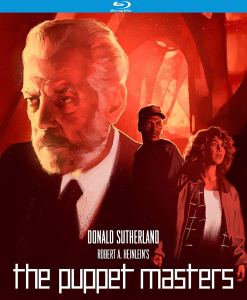Sutherland Searches for Slugs From Saturn In Shaky Sci-Fi Story
Directed By Stuart Orme / 1994
Kino Lorber Studio Classics
Street Date December 4, 2018

So what’s that emotion you feel when you go into a movie expecting it to be terrible, it actually starts out pretty good, but then fails to sustain the momentum resulting in a disappointing finish? The Puppet Masters was never as bad as I feared it might be going in, but the last half of the movie fails to live up to the smart action and suspense of the first, but it was overall better than I expected, but it could’ve been better still! I was on an emotional rollercoaster the whole time, I tell ya!
Donald Sutherland leads a task force combating an alien threat that takes over people’s minds and bodies. Luckily, he’s got some experience with that sort of thing, having been in 1978’s Invasion of the Body Snatchers. This time around, however, the threat isn’t pod people, but small space slugs that hook into your nervous system. Sutherland is assisted in his task by a generically handsome lunk played by Eric Thal (Six Degrees of Separation, Snow Falling On Cedars). Julie Warner (Tommy Boy, Flatliners) is a government scientist reassigned to Sutherland’s crew. A few familiar faces (Richard Belzer, Keith David, Will Patton) also pop up in small parts, some of which amount to little more than a cameo (does Yaphet Kotto even have more than one line in this movie?).

The team catches on to the nature of the alien threat they face fairly early on, and to their credit, they take steps to make sure none of them have been puppetized. We can also thank the screenwriters as well. As written by the team of Ted Elliott and Terry Rossio (Shrek, Aladdin), and rewritten by David S. Goyer (Blade, Dark City, Batman Begins)- as well as a reported 6 other uncredited writers- the first act of The Puppet Masters is a welcome surprise. The team’s initial investigation of the outbreak’s epicenter, their discovery of the aliens and escape from the town are well-paced and exciting. When a member of the team later notices one of his colleagues uncharacteristically turn down a cigarette, Sutherland’s immediate response is to demand a slug-check! Finally we have alien experts that don’t act like total idiots.
Things start slowing the heck down in the second act, however. And it goes right off the rails in the third. There’s a lot of wheel spinning as characters get possessed, freed and repossessed with regularity. The budgetary limitations also begin to show plainly. There’s a lot of running around in the same convention center that does double duty as both an Expo Hall where the President is giving a speech as well as the Des Moines, Iowa City Hall (!). When the characters finally locate and infiltrate the alien’s hive, the set design is about as convincing as those of a high school’s ‘Enchantment Under the Sea’ dance.

One area where the film really shines, though, is with the little animatronic alien slugs. These little guys aren’t as intricate or awesome as, say, the alien queen in Aliens, but it’s clear a lot of thought and care went into the designs of their interior mechanisms. The resulting fluid movements go a long way to sell the illusion that these slimy chunks of rubber are a threat to the whole human race.
But it’s a shame that given the squadron of writers they had working on this movie (based on a book by Robert Heinlein, no less), that no one could figure out how to maintain the thrills and momentum of the first act. Terry Rossio has written at length about the issues and problems he and his writing partner Ted Elliot had with Disney while developing the screenplay. They wanted a screenplay that hewed closely to the source material, Disney execs demanded sweeping changes. More writers were brought on, competing drafts were developed, things get settled, and then a director comes on board, throws out all the previous work and starts the process anew. It’s a process fleshed out in painful detail in John Gregory Dunne’s book Monster, detailing the years-long development of a screenplay that eventually became the movie Up Close and Personal. It’s definitely not a process that tends to produce a great movie.

And The Puppet Masters is not, in the end, a great movie. It starts out with some promise, but the story gets all muddled the further along it goes. I guess I should’ve checked for alien mind-controlling parasites once I realised the movie was becoming uncharacteristically awful.
Kino-Lorber’s Blu-Ray release of The Puppet Masters is pretty great, though. It’s jammed pack with features. They include a feature-length commentary from director Orme and editor John , art galleries, and featurettes on the animatronic designs. There are also recent interviews with actors Julie Warner, Keith David and Richard Belzer. The real gem is the half-hour documentary on author Robert Heinlein. For fans of The Puppet Masters, this disc is a must-have.


